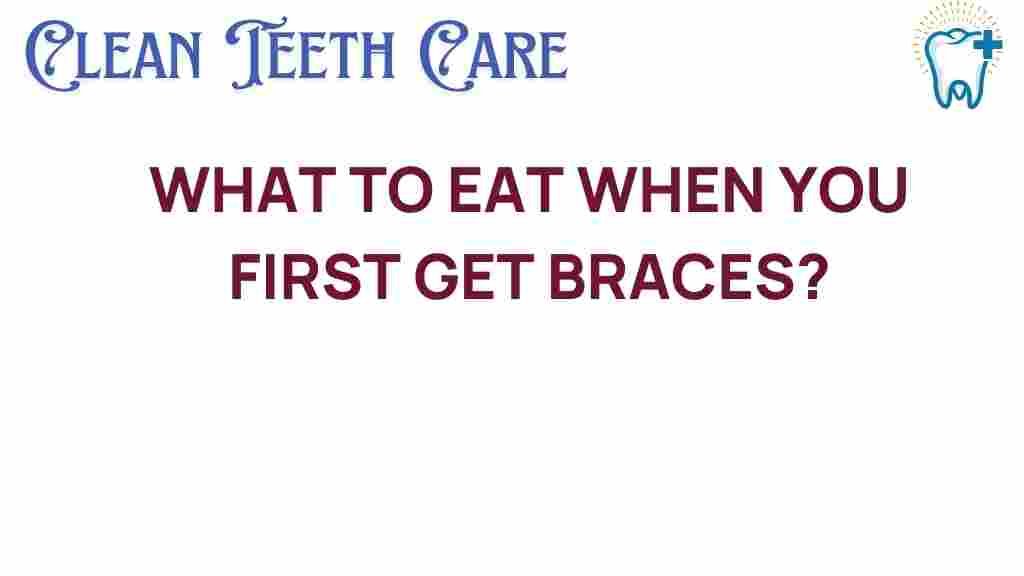Getting braces is an important step in achieving a healthier and more aesthetically pleasing smile. However, it also requires some adjustments, particularly when it comes to your diet. The braces diet can be a challenge initially, as your mouth may experience discomfort and sensitivity. In this article, we will explore the best food tips, dietary adjustments, and braces-friendly meals to help you navigate your eating habits during orthodontic care.
Understanding the Importance of a Braces Diet
Your diet plays a crucial role in maintaining dental health and ensuring the success of your orthodontic treatment. Eating the wrong foods can lead to discomfort, damage to braces, and even prolonged treatment times. Therefore, making informed choices about what to eat is essential. Here’s how you can adjust your diet effectively:
- Minimize discomfort
- Avoid damaging your braces
- Ensure proper nutrition
Soft Foods: The Cornerstone of Your Braces Diet
When you first get braces, your teeth and gums may be sore. Soft foods are the best option to minimize discomfort while still providing the nutrition your body needs. Here are some excellent choices to include in your braces-friendly meals:
- Mashed Potatoes: Creamy and easy to eat, mashed potatoes are a comforting choice.
- Applesauce: A great alternative to whole fruits, it’s nutritious and gentle on your mouth.
- Yogurt: Packed with probiotics, yogurt can help maintain your gut health.
- Oatmeal: A warm, filling breakfast option that is easy to chew.
- Soups: Blended soups like tomato or butternut squash are nutritious and simple to consume.
- Scrambled Eggs: A protein-rich, soft option for any time of the day.
- Bananas: Soft and easy to mash, bananas are a great source of potassium.
- Steamed Vegetables: Soft-cooked veggies like carrots or zucchini can provide essential nutrients without the crunch.
Braces-Friendly Meals: Ideas for Every Meal
Now that you know which soft foods to include in your braces diet, here are some meal ideas for breakfast, lunch, and dinner:
Breakfast Ideas
- Oatmeal topped with honey and mashed bananas
- Greek yogurt with soft berries and a drizzle of honey
- Scrambled eggs with avocado
Lunch Ideas
- Blended vegetable soup with a side of soft bread
- Mashed sweet potatoes with soft-cooked chicken
- Applesauce and cottage cheese bowl
Dinner Ideas
- Soft pasta with marinara sauce and ground turkey
- Steamed fish with mashed potatoes and soft vegetables
- Risotto with mushrooms and peas
Snacks and Desserts
Snacking is often a part of the day, and there are numerous braces-friendly snacks to consider:
- Jell-O or pudding
- Soft cheeses like ricotta or cream cheese
- Fruit smoothies made with soft fruits and yogurt
- Soft granola bars (check for no hard nuts)
Hydration: The Unsung Hero of Dental Health
Staying hydrated is crucial for overall health and can help ease mouth discomfort. Consider drinking:
- Water
- Herbal teas
- Natural fruit juices (avoid acidic ones if your mouth is sore)
Foods to Avoid: What Not to Eat with Braces
Equally important as knowing what to eat is knowing what to avoid. Certain foods can damage your braces or worsen your mouth discomfort:
- Hard Foods: Nuts, hard candies, and ice can break brackets.
- Sticky Foods: Gum, caramel, and taffy can stick to braces and pull them off.
- Crunchy Foods: Popcorn, chips, and raw vegetables can cause pain or damage.
- Acidic Foods: Citrus fruits and vinegar can irritate sore gums.
Tips for Managing Mouth Discomfort
Aside from adjusting your diet, here are some tips to ease mouth discomfort when you first get braces:
- Use orthodontic wax on brackets that feel sharp.
- Rinse your mouth with warm salt water to reduce inflammation.
- Take over-the-counter pain relief as recommended by your orthodontist.
- Cold packs applied to the outside of your mouth can help numb soreness.
Dietary Adjustments: Keeping Your Nutrition on Track
Your braces diet should not only focus on soft foods; it should also ensure you are getting balanced nutrition. Here are some dietary adjustments to consider:
- Increase Protein Intake: Soft meats, dairy, and legumes can help you meet your protein needs.
- Incorporate Fruits and Vegetables: Choose soft or cooked options for essential vitamins and minerals.
- Limit Sugary Foods: To maintain dental health, reduce sweets and opt for healthier alternatives.
Internal and External Resources for Orthodontic Care
For more information on maintaining dental health during your braces treatment, consider consulting your orthodontist or visiting reputable dental health websites. You can also check this guide on orthodontic care for more tips.
Conclusion: Embrace the Journey to a Healthier Smile
Adjusting to a braces diet may seem daunting initially, but with the right food tips and meal ideas, you can navigate this phase with ease. By focusing on soft foods, staying hydrated, and avoiding damaging snacks, you will support your dental health while minimizing discomfort. Remember, this is a temporary adjustment on your journey to a beautiful smile. Be patient and embrace the process!
As you adapt to your braces diet, keep in mind that your orthodontist is your best resource for personalized advice. Regular check-ups will also help ensure your treatment is progressing as planned. Stay positive, and enjoy your braces journey!
This article is in the category Treatments and created by CleanTeethCare Team
